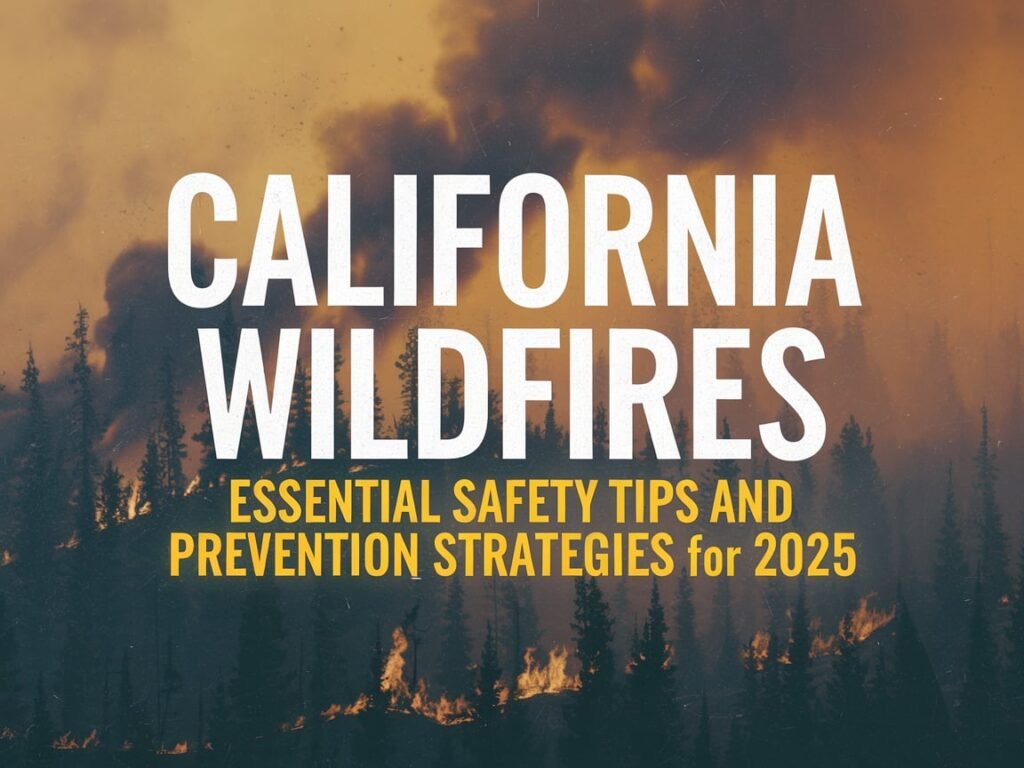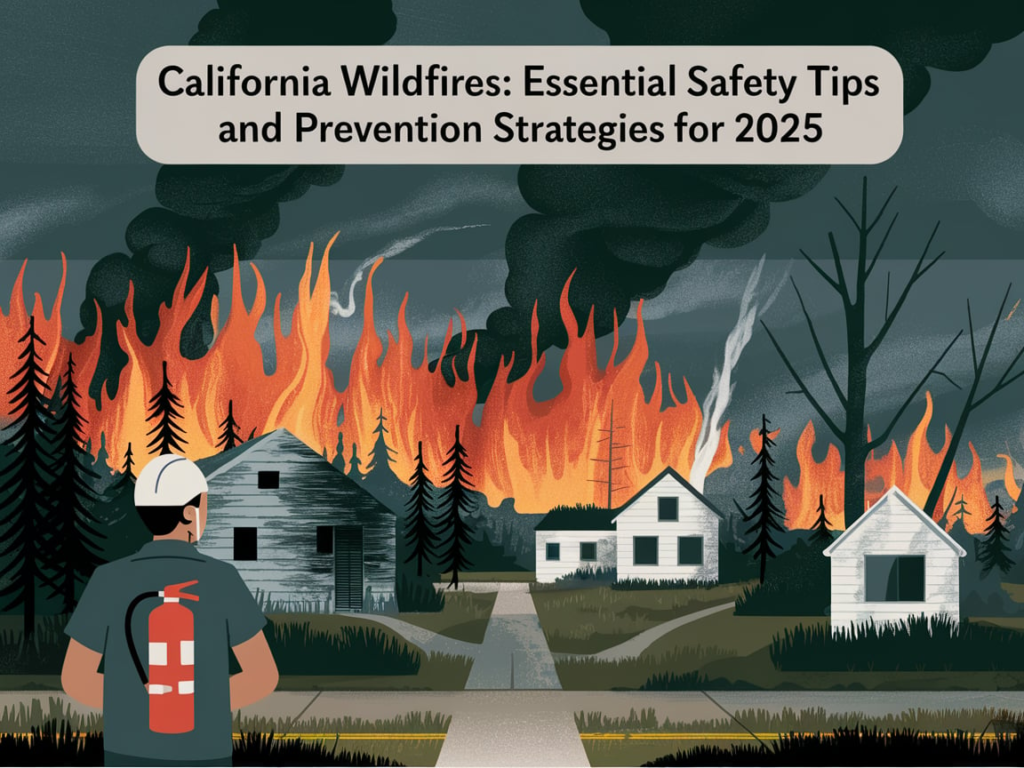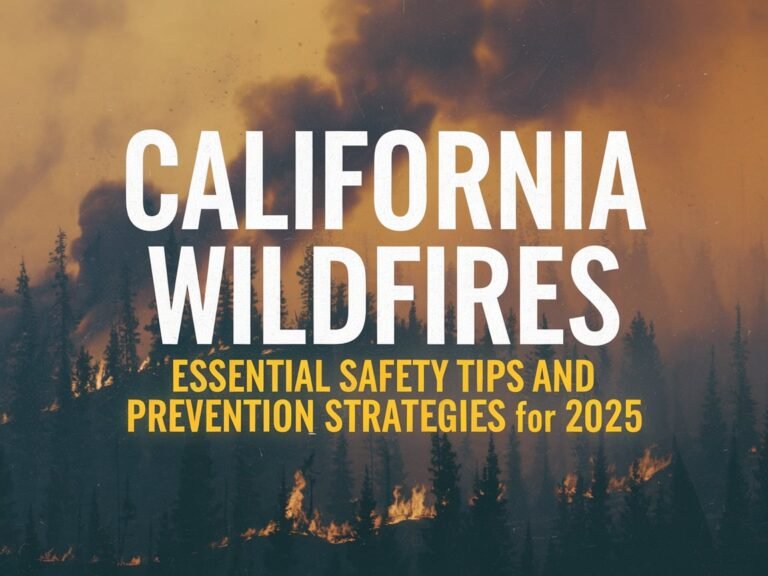
"Stay prepared and safe during California's wildfire season with essential tips and prevention strategies. Learn how to protect your home and family in 2025. #CaliforniaWildfires #FireSafety #StaySafe"
Meta Description:
Learn everything you need to know about California wildfires – their causes, impacts, safety measures, and how to prepare for and respond to these natural disasters. Stay informed and protect your home.
Understanding California Wildfires: Prevention, Safety, and Response
California is home to some of the most destructive wildfires in the United States. Every year, wildfires ravage vast areas of land, causing immense damage to homes, communities, and the environment. Understanding the causes, impacts, and safety measures related to wildfires is crucial for anyone living in or near high-risk areas. In this article, we’ll explore how wildfires start, the effects they have on both people and the environment, and most importantly, how to stay safe and protect your property.
What Are Wildfires?

A wildfire is an uncontrolled fire that spreads rapidly across vegetation, often in forests, grasslands, or brush. These fires can be triggered by natural causes, such as lightning, or by human activity, such as unattended campfires, discarded cigarettes, or electrical malfunctions. Wildfires are especially common in dry, hot climates like California, where the state’s terrain and climate conditions make fires spread quickly.
Causes of Wildfires in California
California’s wildfires are driven by multiple factors, many of which are influenced by human behavior and climate patterns:
- Climate and Weather Conditions: California’s Mediterranean climate, which consists of hot, dry summers and mild, wet winters, creates ideal conditions for wildfires. During droughts or periods with little rainfall, vegetation becomes dry and highly flammable. Winds like the Santa Ana and Diablo winds can quickly spread flames across large areas.
- Human Activity: Human actions account for the majority of wildfire causes in California. Negligence, such as leaving a campfire unattended or improperly disposing of cigarette butts, can lead to devastating fires. Additionally, sparks from machinery, power lines, and arson contribute to wildfire ignition.
- Climate Change: Rising temperatures and prolonged droughts due to climate change have exacerbated the frequency and severity of wildfires in California. These conditions create a volatile environment where wildfires are more likely to ignite and spread rapidly.
- Vegetation and Fuel: Overgrown brush, dry grass, and dead trees provide ample fuel for wildfires. Forest management practices, such as controlled burns and clearing excess vegetation, help reduce fire risks by limiting the amount of fuel available to the flames.
The Impact of Wildfires
Wildfires can have catastrophic effects on both people and the environment:
- Property Destruction: Thousands of homes, businesses, and other structures are destroyed annually in California due to wildfires. Many families are displaced, and the rebuilding process can take years.
- Environmental Devastation: Wildfires decimate ecosystems and destroy wildlife habitats. In addition to the immediate damage to plants and animals, wildfires also contribute to soil erosion and the loss of valuable natural resources.
- Health and Air Quality: Wildfire smoke can travel long distances, affecting air quality even in cities far from the fire’s origin. Exposure to smoke and particulate matter can cause respiratory problems, eye irritation, and worsen conditions like asthma and heart disease.
- Economic Consequences: Wildfires place a heavy financial burden on local and state economies. Firefighting efforts, relief operations, and damage repair can cost billions of dollars annually. Agriculture is also heavily affected, as crops and livestock may be destroyed.
How to Stay Safe During a Wildfire

If you live in a high-risk area, it’s essential to be prepared and know how to stay safe during a wildfire. Here are some tips to help protect yourself, your family, and your property:
- Create a Wildfire Evacuation Plan: Develop a clear plan for evacuating your home. Know multiple escape routes and designate a meeting point in case you’re separated. Make sure all family members, pets, and neighbors are aware of the plan.
- Prepare Your Home: Make your home more fire-resistant by clearing vegetation, leaves, and other flammable materials from around your property. Use fire-resistant materials for roofs, decks, and fences. Install spark arresters on chimneys and keep fire extinguishers in easily accessible locations.
- Stay Informed: Monitor local news, weather reports, and social media for wildfire updates. Many regions have emergency alert systems that provide real-time information about evacuations, air quality, and fire conditions.
- Health Protection During Smoke Exposure: During wildfire smoke events, stay indoors as much as possible. Close windows and doors, and use air purifiers if available. If you must go outside, wear an N95 mask to filter out harmful particles.
- Follow Evacuation Orders: When authorities issue evacuation orders, follow them immediately. Delaying evacuation can put your life at risk. If you have pets, take them with you and ensure they are safe.
How You Can Help
Not everyone is directly impacted by wildfires, but there are several ways you can contribute to the response and recovery efforts:
- Donate to Relief Efforts: Consider donating to organizations that provide support to wildfire victims, such as the Red Cross or local emergency relief agencies.
- Volunteer: Many organizations need volunteers to assist in firefighting efforts, sheltering displaced individuals, and distributing supplies. Look for local volunteer opportunities.
- Spread Awareness: Educate others about wildfire prevention measures, fire safety practices, and the importance of creating defensible space around homes.
- Support Policy Changes: Advocate for policies that address the root causes of wildfires, such as climate change and forest management. Supporting sustainable land management and conservation efforts can help reduce future fire risks.
FAQs:
- What is the first thing I should do when a wildfire is near?
- Evacuate immediately if told to do so. Follow your evacuation plan, ensure all family members and pets are safe, and take important documents with you.
- How can I make my home more fire-resistant?
- Remove dead plants and brush from your property, clear gutters of leaves, install fire-resistant roofing, and use non-flammable materials for decks and fences.
- How do I protect my health from wildfire smoke?
- Stay indoors, close windows, and use an air purifier. Wear an N95 mask if you must go outside.
- Why are California wildfires getting worse?
- Rising temperatures, prolonged droughts, and human activity have made California’s fire seasons more intense. Climate change is also contributing to more severe weather conditions.
- Can I volunteer during a wildfire emergency?
- Yes, many local organizations and firefighting teams welcome volunteers. Check with local agencies or disaster relief organizations for volunteer opportunities.
Useful Resources:
- CAL FIRE – California Department of Forestry and Fire Protection
Real-time wildfire updates, safety tips, and emergency alerts from the official state wildfire authority. - American Red Cross – Wildfire Safety
Learn how to stay safe during wildfires and how to support relief efforts for wildfire victims. - Ready.gov – Wildfire Safety
Information on creating an emergency plan, preparing your home, and staying safe during a wildfire. - National Fire Protection Association (NFPA)
Fire prevention tips, defensible space guidelines, and safety recommendations for residents in wildfire-prone areas. - AirNow – Air Quality Monitoring
Access air quality information during wildfire events to protect yourself from harmful smoke exposure.
Conclusion
California wildfires are a growing threat, but with the right preparation, safety measures, and support, communities can mitigate their impact. By staying informed and being proactive about safety, we can reduce the risks posed by wildfires and help protect both lives and property.




